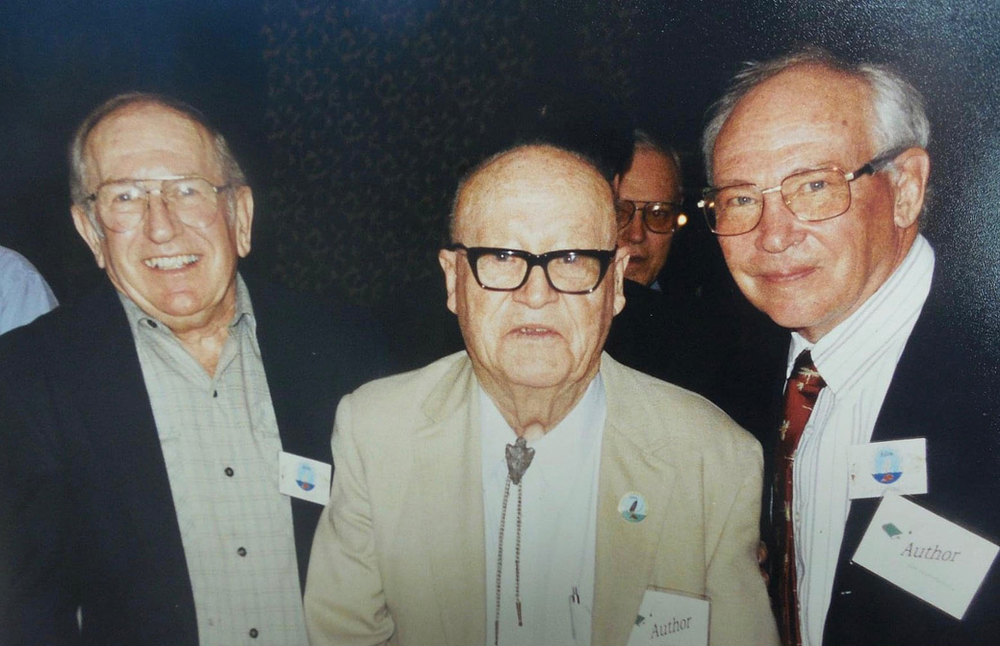George Harvey: The Dean of Fly Fishing

Three fly fishing legends: George Harvey (middle) with Ed Shenk (left) and Joe Humphreys (right). Photo used courtesy of Bill Skilton and the Pennsylvania Fly Fishing Museum
George Harvey was born in 1911 in DuBois, PA. Often referred to as the “Dean of Fly Fishing,” Harvey’s ideas were innovative and groundbreaking back in the time they were developed.
How Harvey came to create the fly fishing course at Penn State University is an interesting story. During a speech on agriculture in 1931, Dean Ralph Watts invited anyone interested in learning to fish to join him one day and he would teach them. Harvey took him up on the offer. Harvey was a student and standout athlete at PSU at the time, and the only PSU athlete to captain the freshman and varsity track and cross country team. In 1936, he missed out on the opportunity to compete in the USA Olympic Trials due to a bout with pneumonia.
When Dean Watts picked Harvey up to go fishing one fateful morning in 1931, it was the Dean who got an education. By day’s end, Harvey had landed well over his limit of 25 fish. From then on, other professors at PSU sought out Harvey for fishing advice and later encouraged him to create a fly fishing class, which he did in 1934. Although non-credited at the time, it was the first of its kind in the United States, eventually gaining accreditation in 1947, also a U.S. first. During his 40 years at PSU, Harvey taught over 35,000 students the fundamentals of fly fishing and fly tying before retiring in 1972 and handing the reins over to his fishing companion and legendary angler Joe Humphreys.
Throughout his career, Harvey worked on a number of research projects, from studying brook trout on Kettle Creek to spending summers working for the Pennsylvania Fish Commission at Fisherman’s Paradise. A public access section of Spruce Creek is named after him.
According to this article on the website for Pennsylvania Center for the Book: “In 1935, Harvey went to Penn State Mont Alto to establish a Physical Education program at their Forestry School. There Harvey taught all of the Physical Education and horticulture courses and coached soccer. He said he met his greatest catch in 1940, his wife Helen. They married after only a few months and never argued once throughout their 54-year marriage before she passed away. They had a daughter Susie, who lives in Arizona, and did everything together throughout their marriage, including tying flies on a nightly basis and earning enough money to pay off the mortgage on their home.”

Many of the tactics in “Techniques of Trout Fishing and Fly Tying” were groundbreaking when they were first developed many decades ago. They’ve become the foundation for many of the techniques that we use today.
Harvey’s first book, Techniques of Fly Tying and Trout Fishing was released in 1976. Oddly enough, he would rewrite and expand the book before republishing it in 1985 under the title Techniques of Trout Fishing and Fly Tying.
It’s easy to read this book and overlook its importance because so many of these tactics have become foundational techniques for modern fly fishers. But keep in mind that this is an “original source” and Harvey was a pioneer for many of the techniques that are considered common knowledge today. Leader design and how to deliver better fly presentations to cagey fish are key topics in this book, and the George Harvey dry fly leader formula is still in practice today.
Harvey was also a key influence in popularizing fly fishing at night, which is something that he certainly passed on to Joe Humphreys as well. Harvey’s Night Fly, aka the Pusher Fly, was revolutionary for its time. Although not specifically mentioned in this book, the theory of pusher flies is probably more in practice today than back then, which is that flies used at night work better when they have a large acoustic footprint. This is why many of today’s night patterns (and streamer patterns, in general) are bulky, designed to “move water,” a concept that pusher flies certainly pioneered.
In his book, Harvey writes that he kept these pusher flies a secret for almost 15 years before sharing them with only his closest friends. Among those early benefactors of this pattern was Humphreys, who in 1977 used a Pusher Fly to catch (at night) a 34-inch, 15 pound 5 ounce brown trout that was at the time a state record.
Throughout his career, and long after retirement, George Harvey delivered hundreds of presentations and did interviews with countless newspapers and magazines. In fact, local newspapers in the 1940s and 50s often featured stories telling readers how Harvey fared opening day of trout season. George Harvey was famous.
With the help of Dan Shields, Harvey co-authored his memoir George Harvey: Memories, Patterns, and Tactics in 1998. He enjoyed writing poetry, and was a heck of a writer on all accounts. His books are written in precise language that is almost lyrical at times, and his storytelling is most captivating. Both of his books belong on every fly fisher’s shelf.
George Harvey passed away in 2008. He was inducted into the National Fly Fishing Hall of Fame in the Catskills as well as the Pennsylvania Fly Fishing Museum in Carlisle, PA.
—————————————
Recently, I purchased a copy of Harvey’s book, Techniques of Trout Fishing and Fly Tying. One of the first pages I opened to regarded night fishing, and soon after, the tying instructions for his pusher flies. Below is the video I did of tying George Harvey’s Pusher Flies according to the recipe found in this book. Hope you enjoy, and please like and subscribe.
Did You Enjoy Reading About George Harvey?
Stay up to date with the Dark Skies Fly Fishing monthly newsletter for free and receive the latest in fly fishing news, tricks, tips, and techniques, stream reports, as well as updates on new flies added to the Online Store and exclusive discounts!
Sign Up Now